The vice president of Bolivia (Spanish: Vicepresidente de Bolivia), officially known as the vice president of the Plurinational State of Bolivia (Spanish: Vicepresidente del Estado Plurinacional de Bolivia), is the second highest political position in Bolivia. The vice president replaces the president in his definitive absence or others impediment and is the ex officio President of the Legislative Assembly.
| Vice President of the Plurinational State of Bolivia | |
|---|---|
| Vicepresidente del Estado Plurinacional de Bolivia | |
 Coat of arms of Bolivia | |
| Residence | Vice Presidential Palace |
| Seat | La Paz |
| Nominator | Plurinational Electoral Organ |
| Appointer | Direct popular vote (two rounds if necessary) |
| Term length | Five years, renewable once consecutively[1][2] |
| Inaugural holder | José Ramón de Loayza |
| Formation | 19 November 1826 |
| First holder | Álvaro García Linera[a] |
| Salary | 22,904 bolivianos per month[3] |
| Website | www.vicepresidencia.gob.bo |
Thirty nine men have served as vice president of Bolivia since the office came into existence on 19 November 1826. José Ramón de Loayza was the first vice president of the Republic of Bolivia. The 38th vice president, Álvaro García Linera, was the last vice president of the Republic of Bolivia and the first vice president of the Plurinational State of Bolivia. The second and current vice president of the Plurnational State is David Choquehuanca (since 8 November 2020). There are currently five living former vice presidents. The most recent former vice president to die was Julio Garrett Ayllón on 19 March 2018.
The vice president is the first person in the presidential line of succession and assumes the presidency if the president dies, resigns, or is impeached and removed from office. Four vice presidents have ascended to the presidency following the resignation of their predecessor (José Luis Tejada Sorzano, Mamerto Urriolagoitía, Jorge Qurioga, and Carlos Mesa). René Barrientos was the only vice president to assume the presidency by deposing his own predecessor, Víctor Paz Estenssoro. When Barrientos died suddenly on 27 April 1969, Luis Adolfo Siles Salinas became the only vice president to become president through their predecessor's death.
Seven former vice presidents (Aniceto Arce, Mariano Baptista, Severo Fernández, Eliodoro Villazón, Hernán Siles Zuazo, René Barrientos, and Jaime Paz Zamora) were elected president in their own right while two (José Miguel de Velasco and Mariano Enrique Calvo) became president by other means. José Miguel de Velasco was the only vice president who had already served as president (1828) prior to becoming vice president.
Vice presidents
Republic of Bolivia (1826–1836)
The office of vice president was first established on 19 November 1826, during the presidency of Antonio José de Sucre, following the promulgation of the Political Constitution of 1826, the first in the country's history.[4] However, Sucre himself would never elect a candidate to be presented to the National Congress, leaving the position vacant throughout his term. The first elected vice president was José Miguel de Velasco on 12 August 1828. However, he was prevented from exercising the position as he instead served as interim president in the absence of the elected president Andrés de Santa Cruz.[5]
As Santa Cruz never appeared to take office, the Conventional Assembly convened on 18 December 1828 to elect new leaders. José Ramón de Loayza would be elected vice president to Pedro Blanco Soto. Loayza served as acting president in the absence of Soto until 26 December at which point Soto assumed the office of the presidency and Loayza would exercise the vice presidency for the first time.[6]
| Vice Presidency | Vice President | Party | Designation | Government | President | |||
|---|---|---|---|---|---|---|---|---|
| Office vacant 19 November 1826 – 18 December 1828 | Antonio José de Sucre | |||||||
| José María Pérez de Urdininea | ||||||||
| Jose Miguel de Velasco Franco | ||||||||
| 1 | 18 December 1828 – 1 January 1828 End of mandate | 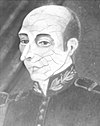 | José Ramón de Loayza | Independent | Elected by the Constituent Assembly | Provisional | Acting to 26 Dec. 1828 | |
| Pedro Blanco Soto | ||||||||
| Office vacant 1 – 31 January 1829[b] | ||||||||
| 2 | 31 January 1829 – 23 July 1835 Dismissed |  | José Miguel de Velasco Franco | Independent | Elected by the Constituent Assembly | Provisional (31 January 1829) | Acting to 24 May 1829 | |
| Reelected by the Constituent Congress | Constitutional[8] (14 August 1831) | Andrés de Santa Cruz | ||||||
| 3 | 23 July 1835 – 28 October 1836 Legal change |  | Mariano Enrique Calvo | Independent | Appointed by Andrés de Santa Cruz | Constitutional | ||
Bolivian State (1836–1839)
The Bolivian State was one of the three states that made up the Peru-Bolivian Confederation. On 28 October 1836, Andrés de Santa Cruz was elected Supreme Protector of the Peru-Bolivian Confederation while simultaneously being the president of the Bolivian State. José Miguel de Velasco Franco remained Vice President of the Bolivian State until 23 July 1835 when he was replaced by Mariano Enrique Calvo. For much of his tenure, Calvo would serve as acting president in replacement of Santa Cruz when he was in Peruvian territory.
| Vice Presidency | Vice President | Party | Designation | Government | President | |||
|---|---|---|---|---|---|---|---|---|
| 3 | 28 October 1836 – 20 February 1839 Resigned from office |  | Mariano Enrique Calvo | Independent | Elected by the Congress of Tapacarí | Constitutional | Andrés de Santa Cruz | |
| Acting since 1836[c] | ||||||||
Republic of Bolivia (1880–2009)

Upon the dissolution of the Peru-Bolivian Confederation, Jose Miguel de Velasco overthrew Marshal Andrés de Santa Cruz and assumed the presidency of the Bolivian State on 22 February 1839, bringing an end to it and reviving the Republic of Bolivia with his secessionist pronouncement. On 26 October 1839, de Velasco promulgated the Political Constitution of 1839 which eliminated the position of vice president making the President of the Senate the first in the presidential order of succession instead.[9] This situation lasted until 15 February 1878, when the Political Constitution of 1878 was promulgated under Hilarión Daza.[10] The Constitution of 1878 reincorporated the position of vice president, though it remained vacant for the remainder of Daza's presidency.
Following the overthrow of Daza, during the presidency of Narciso Campero, the unique feature of two vice presidents came to be. On 31 May 1880, the National Convention appointed Aniceto Arce and Belisario Salinas, respectively, as first and second vice presidents. The dual-vice presidency was formally established upon the promulgation of the Political Constitution of 1880 on 28 October.[11] The Constitution of 1880 established two vice presidents who were elected like the president by direct vote, but with different powers: The first vice president presided over the Senate and was empowered to replace or succeed the president while the second vice president only had the function of replacing or succeeding the president in case of absence, resignation, inability or death of the first vice president.
This dual form of vice presidents was in force until 24 January 1921 when the Congress-Convention of 1921, convened by Bautista Saavedra, abolished the position of second vice president.[12] On 4 December 1939, interim president Carlos Quintanilla would amend the 1938 Constitution to abolish the office of the vice presidency in order to circumnavigate the claims to succession of former vice president Enrique Baldivieso.[13] The position was revived on 24 November 1945 with the promulgation of the Political Constitution of 1945 during the presidency of Gualberto Villarroel.[14]
| Vice Presidency | Vice President | Party | Designation | Government | President | |||
|---|---|---|---|---|---|---|---|---|
| Office vacant 22 February – 26 October 1839 | Jose Miguel de Velasco Franco | |||||||
| Office blank 26 October 1839 – 15 February 1878 | List | |||||||
| Office vacant 15 February 1878 – 31 May 1880 | Hilarión Daza | |||||||
| Narciso Campero | ||||||||
| 4 | 31 May 1880 – 11 March 1881 Dismissed |  | Aniceto Arce | Conservative | Elected by the National Convention | Constitutional (1st) | ||
| Office vacant 11 May 1881 – 4 September 1884 | ||||||||
| 5 | 31 May 1880 – 4 September 1884 End of term |  | Belisario Salinas | Constitutional (2nd) | ||||
| 6 | 4 September 1884 – 15 August 1888 End of term |  | Mariano Baptista | Conservative | General Election of 1884 | Constitutional (1st) | Gregorio Pacheco | |
| 7 | 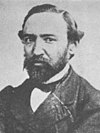 | Jorge Oblitas | Constitutional (2nd) | |||||
| 8 | 15 August 1888 – 11 August 1892 End of term |  | José Manuel del Carpio | Conservative | General Election of 1888 | Constitutional (1st) | Aniceto Arce | |
| 9 |  | Serapio Reyes Ortiz | Constitutional (2nd) | |||||
| 10 | 11 August 1892 – 19 August 1896 End of term |  | Severo Fernández | Conservative | General Election of 1892 | Constitutional (1st) | Mariano Baptista | |
| – | Office vacant[d] | |||||||
| 11 | 19 August 1896 – 12 April 1899 Deposed by a coup d'état |  | Rafael Peña de Flores | Conservative | General Election of 1896 | Constitutional (1st) | Severo Fernández | |
| 12 |  | Jenaro Sanjinés | Constitutional (2nd) | |||||
| Office vacant 12 April – 25 October 1899 | ||||||||
| 13 | 25 October 1899 – 23 January 1903 Dismissed |  | Lucio Pérez Velasco | Liberal | Elected by the National Convention | Constitutional (1st) | José Manuel Pando | |
| Office vacant 23 January 1903 – 14 August 1904 | ||||||||
| 14 | 25 October 1899 – 14 August 1904 End of term |  | Aníbal Capriles Cabrera | Constitutional (2nd) | ||||
| 15 | 14 August 1904 – 12 August 1909 End of term |  | Eliodoro Villazón | Liberal | General Election of 1904 | Constitutional (1st) | Ismael Montes | |
| 16 | 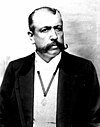 | Valentín Abecia Ayllón | Constitutional (2nd) | |||||
| 17 | 12 August 1909 – 14 August 1913 End of term |  | Macario Pinilla Vargas | Liberal | General Election of 1909 | Constitutional (1st) | Eliodoro Villazón | |
| 18 | 12 August 1909 – 1 October 1915 Died in office |  | Juan Misael Saracho | Constitutional (2nd) | ||||
| Liberal | General Election of 1913 | Constitutional (1st) | Ismael Montes | |||||
| 19 | 14 August 1913 – 15 August 1917 End of term |  | José Carrasco Torrico | Constitutional (2nd) | ||||
| 20 | 15 August 1917 – 12 July 1920 Deposed by a coup d'état |  | Ismael Vázquez Virreira | Liberal | General Election of 1917 | Constitutional (1st) | José Gutiérrez Guerra | |
| 21 | 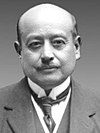 | José Santos Quinteros | Constitutional (2nd) | |||||
| Office vacant 13 July 1920 – 10 January 1926 | Bautista Saavedra | |||||||
| Felipe Segundo Guzmán | ||||||||
| 22 | 10 January 1926 – 28 May 1930 De facto exiled[e] |  | Abdón Saavedra | PRS | General Election of 1925 | Constitutional | Hernando Siles Reyes | |
| Office vacant 28 May 1930 – 5 March 1931 | Carlos Blanco Galindo | |||||||
| 23 | 5 March 1931 – 1 December 1934 Assumed presidency |  | José Luis Tejada Sorzano | Liberal | General Election of 1931 | Constitutional | Daniel Salamanca Urey | |
| Office vacant 1 December 1934 – 28 May 1938 | José Luis Tejada Sorzano | |||||||
| David Toro | ||||||||
| Germán Busch | ||||||||
| 24 | 28 May 1938 – 24 April 1939 Dismissed |  | Enrique Baldivieso | PSU | Elected by the National Convention | Constitutional | ||
| Office vacant 24 April – 4 December 1939 | ||||||||
| Carlos Quintanilla | ||||||||
| Office blank 4 December 1939 – 24 November 1945 | ||||||||
| Enrique Peñaranda | ||||||||
| Gualberto Villarroel | ||||||||
| 25 | 6 November 1945[f] – 21 July 1946 Deposed by a coup d'état |  | Julián Montellano | MNR | Elected by the National Convention | Constitutional | ||
| Office vacant 21 July 1946 – 10 March 1947 | Néstor Guillén | |||||||
| Tomás Monje | ||||||||
| 26 | 10 March 1947 – 24 October 1949 Assumed presidency[g] |  | Mamerto Urriolagoitía | PURS | General Election of 1947 | Constitutional | Enrique Hertzog | |
| Office vacant 22 October 1949 – 11 April 1952 | Mamerto Urriolagoitía | |||||||
| Hugo Ballivián | ||||||||
| 27 | 11 April 1952 – 6 August 1956 End of term | 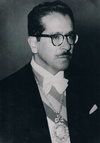 | Hernán Siles Zuazo | MNR | Installed by a coup d'état | De facto | Acting to 15 Apr. 1952 | |
| Víctor Paz Estenssoro | ||||||||
| 28 | 6 August 1956 – 24 June 1957 Resigned from office |  | Ñuflo Chávez Ortiz | MNR | General Election of 1956 | Constitutional | Hernán Siles Zuazo | |
| Office vacant 24 June 1957 – 6 August 1960 | ||||||||
| 29 | 6 August 1960 – 6 August 1964 End of term |  | Juan Lechín Oquendo | MNR | General Election of 1960 | Constitutional | Víctor Paz Estenssoro | |
| 30 | 6 August 1964 – 4 November 1964 Assumed presidency |  | René Barrientos | MNR | General Election of 1964 | Constitutional | ||
| Office vacant 5 November 1964 – 6 August 1966 | René Barrientos | |||||||
| Alfredo Ovando Candía | ||||||||
| 31 | 6 August 1966 – 27 April 1969 Assumed presidency |  | Luis Adolfo Siles Salinas | PSD | General Election of 1966 | Constitutional | René Barrientos | |
| Office vacant 27 April 1969 – 10 October 1982 | ||||||||
| 32 | 10 October 1982 – 14 December 1984 Resigned from office |  | Jaime Paz Zamora | MIR | General Election of 1980[h] | Constitutional | Hernán Siles Zuazo | |
| Office vacant 14 December 1984 – 6 August 1985 | ||||||||
| 33 | 6 August 1985 – 6 August 1989 End of term |  | Julio Garrett Ayllón | MNR | General Election of 1985 | Constitutional | Víctor Paz Estenssoro | |
| 34 | 6 August 1989 – 6 August 1993 End of term |  | Luis Ossio | PDC | General Election of 1989 | Constitutional | Jaime Paz Zamora | |
| 35 | 6 August 1993 – 6 August 1997 End of term |  | Víctor Hugo Cárdenas | MRTKL | General Election of 1993 | Constitutional | Gonzalo Sánchez de Lozada | |
| 36 | 6 August 1997 – 7 August 2001 Assumed presidency | 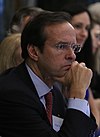 | Jorge Quiroga | ADN | General Election of 1997 | Constitutional | Hugo Banzer | |
| Office vacant 7 August 2001 – 6 August 2002 | Jorge Quiroga | |||||||
| 37 | 6 August 2002 – 17 October 2003 Assumed presidency |  | Carlos Mesa | Independent | General Election of 2002 | Constitutional | Gonzalo Sánchez de Lozada | |
| Office vacant 17 October 2003 – 22 January 2006 | Carlos Mesa | |||||||
| Eduardo Rodríguez | ||||||||
| 38 | 22 January 2006 – 22 January 2010 Legal change |  | Álvaro García Linera | MAS | General Election of 2005 | Constitutional | Evo Morales | |
Plurinational State of Bolivia (2009–present)
The emergence of the Plurinational State occurred as a consequence of the promulgation of the Political Constitution of 2009. Drafted by the Constituent Assembly in 2007, the new constitution was approved in a popular referendum on 25 January 2009, and was promulgated on 7 February. The Constitution resulted in a change in the official name of the country, leaving behind its previous denominative of Republic of Bolivia to become the Plurinational State of Bolivia. In order to comply with the structural changes of the new constitution, it was decided to advance the general elections to be held on 6 December 2009, with Evo Morales and Vice President Álvaro García Linera winning again, with 64.22% of the votes. This situation made Álvaro García Linera the last vice president of the Republic and the first of the Plurinational State.
| Vice Presidency | Vice President | Party | Designation | Government | President | |||
|---|---|---|---|---|---|---|---|---|
| 38 | 22 January 2010 – 10 November 2019 Resigned from office under military pressure |  | Álvaro García Linera | MAS | General Election of 2009 | Constitutional | Evo Morales | |
| General Election of 2014 | ||||||||
| Office vacant 10 November 2019 – 8 November 2020 | Jeanine Áñez | |||||||
| 39 | 8 November 2020 – Incumbent |  | David Choquehuanca | MAS | General Election of 2020 | Constitutional | Luis Arce | |
Timeline

See also
Notes
References
External links
- Vicepresidencia del Estado Plurinacional de Bolivia (in Spanish)
